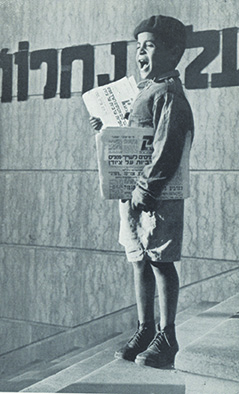×


We have detected your country as:
Please click here to go to the USA website or select another country from the dropdown list.
by: Janet Aslin, BFP Staff Writer
 One morning, as I walked up HaRav Kook Street in downtown Jerusalem, I paused to read a plaque on one of the buildings. I learned that this location was the site where Jerusalem’s first printing press, owned by the Salomon family, had operated from 1939–1992. I’m not sure why it piqued my interest, but I started thinking about newspapers. These days, printed papers are becoming a thing of the past. But it was not always so. Let’s delve into a brief look at the history and development of news and Hebrew papers in Israel.
One morning, as I walked up HaRav Kook Street in downtown Jerusalem, I paused to read a plaque on one of the buildings. I learned that this location was the site where Jerusalem’s first printing press, owned by the Salomon family, had operated from 1939–1992. I’m not sure why it piqued my interest, but I started thinking about newspapers. These days, printed papers are becoming a thing of the past. But it was not always so. Let’s delve into a brief look at the history and development of news and Hebrew papers in Israel.
Near the end of the 400-year rule of the Ottoman Empire (1517–1917), the Jewish people began returning to the Land of Israel. Of course there had always been a yishuv—Jews who remained in the Land even after the Roman conquest in AD 70—but the mid-1800s signaled a shift in the Jewish world in preparation for the waves of aliyah (immigration to Israel) which would begin in the 1880s.
HaLevanon, the first Hebrew-language newspaper published in Israel, was one piece of evidence of the coming changes. The paper made its debut in 1863 and was followed six months later by a second named HaHavatselet. The papers presented two sides of the argument that was emerging. The editor of HaLevanon believed the yishuv should continue to study Torah (Gen.–Deut.), supported by donations from the Jewish community abroad, while HaHavatselet advocated for the development of self-supporting agricultural communities.
Both ran afoul of the Turkish censors and were closed the same year they began publication. HaLevanon moved its operations to Europe but still focused on bringing news of the Jewish yishuv in the Holy Land to the world until the paper permanently closed in 1886. HaHavatselet remained silent until 1870, when it reopened and published a regular weekly paper in Jerusalem until 1911.
Jerusalem treasures its past, so both papers are memorialized by street names in the city center. Though often referred to as the “umbrella street” for its colorful summertime décor, the correct name is Yoel Moshe Salomon Street, named for one of HaLevanon’s founders. And as BFP volunteers, we often walked up HaHavatselet Street on our way to work.
Looking at the press situation during the Mandate Period (1917–1948), Leslie John Martin wrote, “Palestine was a special case in journalism. No other area with a population of two million, of whom at least 30% are illiterate, could boast of 18 morning dailies, three evening papers, and a host of weeklies, biweeklies and monthlies.”
 While there were obviously many Hebrew language newspapers available, there was also a local English language paper. The Jerusalem Post, Israel’s premier English newspaper today, can trace its roots to the Palestine Bulletin, which originated in 1925. In 1932, under the headship of Gershon Agron, the Bulletin became the Palestine Post. It was a strong Jewish voice as it openly opposed the British White Paper, which restricted Jewish immigration. “Zionist organizations considered the newspaper one of the most effective means of exerting influence on British authorities,” Wikipedia argues. After the modern State of Israel was born, the name was changed to the Jerusalem Post.
While there were obviously many Hebrew language newspapers available, there was also a local English language paper. The Jerusalem Post, Israel’s premier English newspaper today, can trace its roots to the Palestine Bulletin, which originated in 1925. In 1932, under the headship of Gershon Agron, the Bulletin became the Palestine Post. It was a strong Jewish voice as it openly opposed the British White Paper, which restricted Jewish immigration. “Zionist organizations considered the newspaper one of the most effective means of exerting influence on British authorities,” Wikipedia argues. After the modern State of Israel was born, the name was changed to the Jerusalem Post.
Political parties owned most of the newspapers that existed at the founding of the State of Israel. It is interesting to note that there were two independent papers, Ha’aretz (1919) and Yediot Aharonot (1939), are they alone have survived until today. Those associated with political parties have gone by the wayside. Ha’aret holds a 4.7% market share, while Yediot Aharonot’s is much larger at 23.9%.
Until 1960, the primary source of news was the print media. Israel had only one radio station, Kol Israel, and there were just a few newscasts each day. As the young country grew stronger economically and there were more advertisers, the independent papers became stronger.
 If Martin were to do his analysis of the press situation in Israel today, he would not find much changed since the British Mandate Period. “In 2015, Reuters correspondent Tova Cohen described Israeli society in 2012 as ‘news-obsessed’.” Although much of today’s news comes via an online platform and “recent years have seen the increased place of radio and television, Israel still boasts one of the world’s highest rates of newspaper readers among its adult population,” the Jewish Virtual Library says.
If Martin were to do his analysis of the press situation in Israel today, he would not find much changed since the British Mandate Period. “In 2015, Reuters correspondent Tova Cohen described Israeli society in 2012 as ‘news-obsessed’.” Although much of today’s news comes via an online platform and “recent years have seen the increased place of radio and television, Israel still boasts one of the world’s highest rates of newspaper readers among its adult population,” the Jewish Virtual Library says.
Israelis’ news obsession is due, in part, to the precariousness of the world in which they live. Since its establishment 75 years ago, the young country has been forced to defend itself in seven wars—approximately one per decade. In that kind of environment, it is critically important to be as prepared as possible for any situation.
So, six days a week, on the streets of Jerusalem, you will see men in red coveralls with stacks of newspapers to hand to automobile drivers and passersby alike. Israel HaYom, a free paper with a circulation of 275,000, is only one of the means by which Israelis get their daily news-fix.
Israel is a country roughly the size of the US state of New Jersey with a total population of 9.026 million—approximately 0.11% of the world’s population. When you consider its size, it is surprising that tiny Israel is in the global news spotlight so much of the time. At any given moment, Israel may be the largest single source of news events reported around the world. And that’s something to ponder.
Photo Credit: Click on photo to see photo credit
Photo License: Newspaper Seller
Photo License: Israel in the Gulf War IX
Photo License: Israel Hayom Jerusalem
All logos and trademarks in this site are property of their respective owner. All other materials are property of Bridges for Peace. Copyright © 2024.
Website Site Design by J-Town Internet Services Ltd. - Based in Jerusalem and Serving the World.